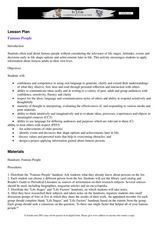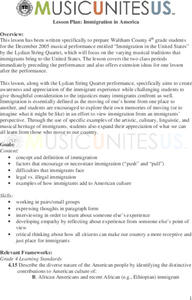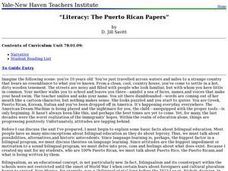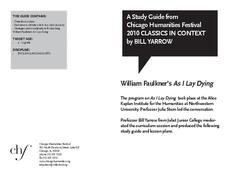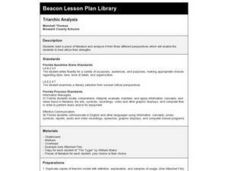Curated OER
Types of Trains
Third graders explore different types of trains. In this science lesson, 3rd graders study the "Orphan Train" and write a paragraph about what it would feel like to be riding a train during this time period.
Curated OER
The "Yellow" Peril
Students discuss what happened on the west coast of the United States in 1942 from the perspective of either Japanese and Japanese Americans or their non-Asisan neighbors. They watch a video, where they are aware of both sides of the...
Curated OER
Publishing With Photos!
Students create books with photographs as illustrations. In this book making lesson, students create books for different subjects to accompany what they are learning. They take photographs to match what they have written.
Curated OER
Types of Things
Students explore the differences between man-made and natural objects. In this instructional activity designed to compare properties of objects, students differentiate between natural and man-made objects and complete an activity...
Curated OER
Model Mania
Eighth graders study the conservation of matter. In this chemical reaction lesson students examine what happens during a chemical reaction and complete a lab activity.
Curated OER
Egg to Chick
Young scholars become familiar with the parts of the egg. In this development of an egg instructional activity, students understand the difference between a fertilized and unfertilized egg. Young scholars and view pictures, while they...
Curated OER
Life in Ancient Greece
Explore ancient history and everyday life of ancient Greece. Learners will use Internet resources to research the culture of ancient Greece in order to complete worksheets regarding the topic. Topics include home, clothing, marriage,...
Curated OER
Understanding Cause and Effect using A Sound of Thunder
Students listen to a short story, A Sound of Thunder, and retell parts of the story which is about time travel. They respond to the story by writing cause/effect outcomes about the ecosystem using a handout.
Curated OER
Clouds
Third graders complete various activities about clouds. They create a cloud in a lab, write a cloud story, make a cloud model and complete a webquest.
Smithsonian Institution
The Proper Gentlemen: George Washington and "The Rules of Civility"
Students read and interpret a portion of the "Rules of Civility." They describe the significance of these rules in Washington's time. They discuss how the rules might be significant in today's world. They write rules of etiquette that...
Curated OER
USING TORTURE ON SUSPECTED TERRORISTS
Learners examine how most countries prohibit torture. They explore why torture is still considered a possible tool for preventing future losses of innocent life. They discuss some of the facts, the mis-perceptions, the arguments, and the...
Curated OER
Immigration in America
Fourth graders examine the musical traditions that immigrants bring to the United States. They discuss the concept of home, complete the "My Home" worksheet, participate in a class discussion, and write a letter to a fourth grade...
Curated OER
Great Caesar’s Ghost
Students explore ancient Rome. In this ancient Rome lesson, students research the Roman social classes and political structure. Students use their findings to write diary entries that describe daily life in Rome.
Curated OER
Managing Multiple Roles
Young scholars identify the roles balanced in family and career activities. In this family and career balance instructional activity, students identify the roles each family member has and discuss problems problems they see in their own...
Curated OER
Transpiration
Students interactively explore the term transpiration. In this science/ecology activity, students discuss what they would do if they were thirsty while conducting research in Brazil. Additionally, students write descriptive words to...
Curated OER
Recycle! Recycle! Recycle!
Students investigate recycling and reusing. They view an online video, create an recycled art collage using picture files in Inspiration software, and write a choral poem about recycling.
Curated OER
Literacy: The Puerto Rican Papers
Learners in an ESL classroom are introduced to new vocabulary before reading a story in their native language. In groups, they discuss how the tradition of writing stories down became a tradition and answer comprehension questions. To...
Curated OER
Regionalism as Seen Through the National Parks
Fifth graders see a video of some of our country's national parks. As each one is introduced they write down its name and location and star* the areas they find unique and interesting. After the video is over they share at least one of...
Curated OER
Honesty
Students listen to the story, "The Mangoes." They answer and discuss a given set of questions then volunteer to share an experience of when they told the truth and what it felt like. Students perform a skit to reinact the story, "The...
Curated OER
Chinese Dragons
Students discover the world of the Chinese dragon by creating their own festive dragon using texture, line, shape, pattern, and color. This lesson is ideal for the early-elementary classroom and includes a recommened reading list.
Curated OER
Just Get to the Good Part
Learners summarize nonfiction text. After reviewing the steps for summarization, students independently read a nonfiction article. They write a summary paragraph using the six-step process outlined by the instructor during guided practice.
Curated OER
William Faulkner's As I Lay Dying
Students analyze William Faulkner's As I Lay Dying. In this literature analysis lesson plan, students compare a modern novel and play. Students analyze Faulkner's interior monologues. Students write a paper about the ways As I Lay Dying...
Curated OER
A Sick Day for Amos McGee
Students read the story A Sick Day for Amos McGee about a zoo keeper who visits all of the animals everyday. In this reading lesson plan, students also make a printmaking art activity that is connected to the story.
Curated OER
Triarchic Analysis
Fourth graders read a piece of literature and analyze it from three different perspectives which enable students to best utilize their strengths. They make a presentation to the class once their analysis is complete.












